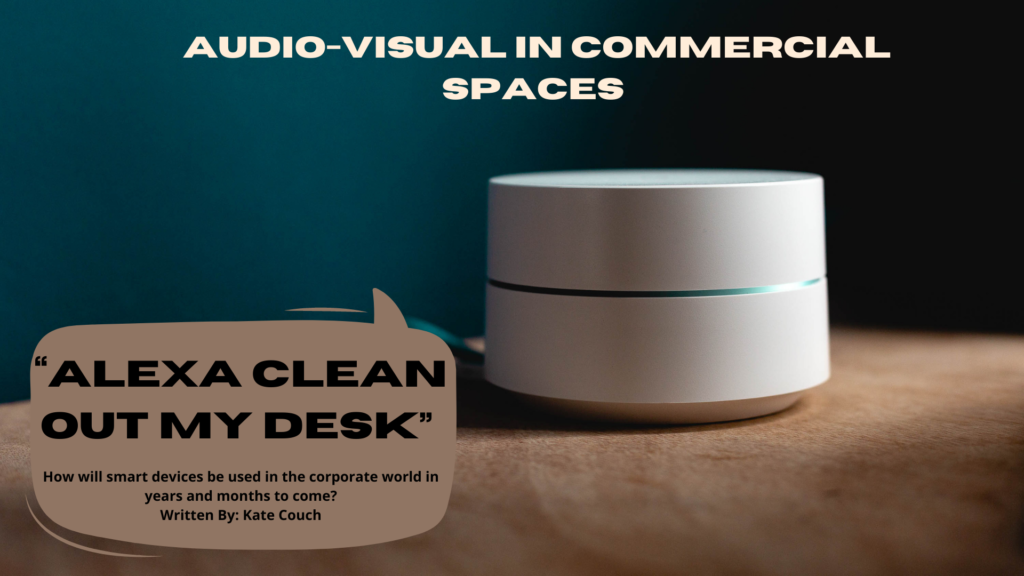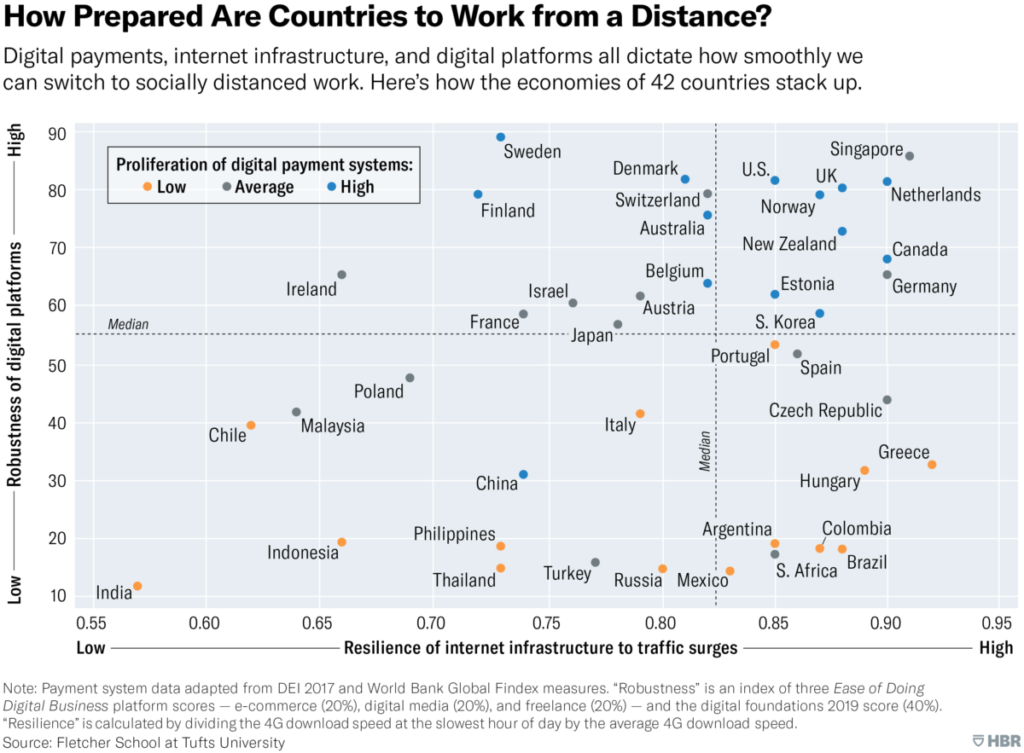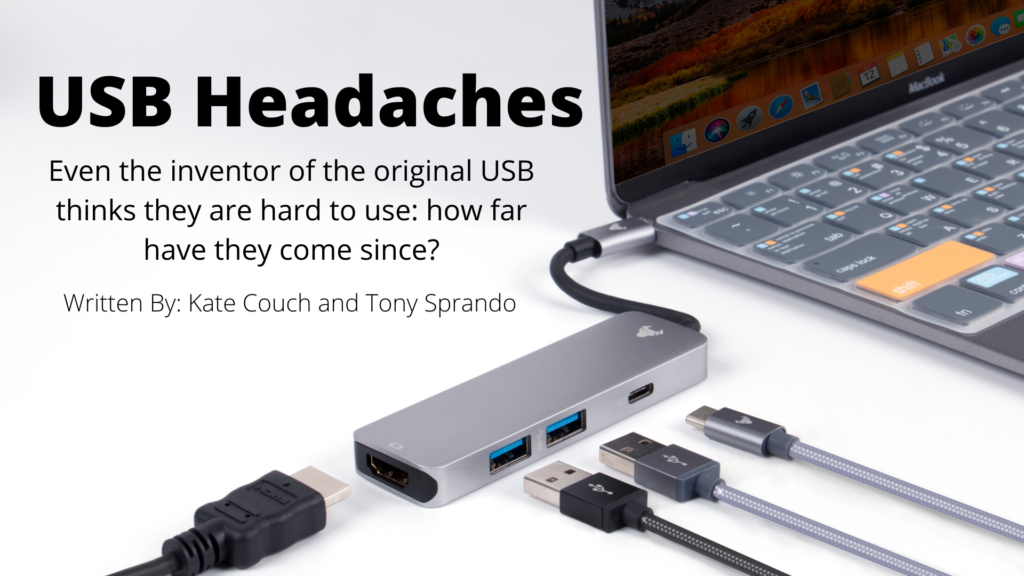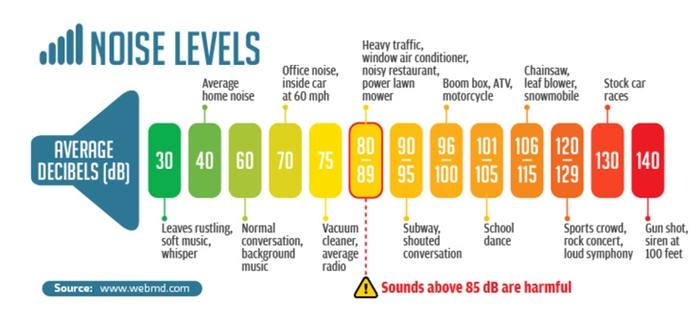
Image and graphic design by, Kate Couch and Canva

Photo and Graphic Design By: Kate Couch

Image and Graphic Design By: Kate Couch with Canva
What does AV look like in other developed countries?
Written By: Kate Couch for AV Bend
It’s very easy to forget how much of the amenities and services we have in the US are available in other countries. Just because they speak a different language than us or have different customs doesn’t mean they’re not using the same computer. In fact, in 2019 Apple sales went up 2% in Europe according to Apple Insider. So what does this mean for AV in other countries?
AV was recently impacted in 2020 when the pandemic hit. This created a need for AV at home and for “Zoom Rooms” in corporate offices. Not every country was prepared to send their employees home due to lack of technology and wifi. Harvard Business Review designed a graph (see below) displaying the readiness of each country. Countries like Norway, the Netherlands, Estonia, and the UK scored high. These countries are highly developed technology-wise and use most of the same technology we use here in the US. Unfortunately, countries like Mexico, Chile, India, and South Africa scored low. Their ability to conform technologically was hindered due to their economic status and because of that, it hit their citizens harder.

Image from Harvard Business Review
The goal is to make these second-world countries more up-to-date when it comes to AV and technology. Companies like the World Intellectual Property Organization (WIPO) are doing studies to raise awareness of this need. Before the pandemic hit in August 2018, WIPO did a study on Africa’s need for audiovisual equipment. It specifically highlights how this would increase the accuracy of economic data collection. Their study was intended to “highlight the importance of gathering audiovisual market data to achieve tangible results in developing effective policies, including for the acquisition, management and use of intellectual property (IP) rights, to strengthen the audiovisual sector in five African countries (Burkina Faso, Côte d’Ivoire, Kenya, Morocco, and Senegal).” Read the full article here. Organizations and studies like these make it possible for second-world countries to become more integrative with recent audiovisual advancements.
Even though other countries in Europe use different outlets than we use here in the US, there isn’t much difference in their audiovisual setups or how they use their technology. This is mainly because they are as economically advanced as the US. Economics plays a huge role in which technology and audiovisual setups are incorporated into the government and into citizens’ daily lives. When it comes to providers and distributors there are slight differences. The European AV Group is a company whose goal is to “Become the most trusted supplier of professional Audio, Video and Control products across Europe,” according to their website. We don’t have this in the US (we have the unaffiliated USAV group which provides similar services) but the content they use and the products they sell are either the same or comparable to those in the US.
Accessibility associated with economics has more to do with the differences in audiovisual than cultural differences. Developed countries model the US in technology and AV very closely. This is important as businesses expand on an employee and customer basis across the globe.
*This article is by Tony Sprando of AV Bend’s intellectual property. To use or reference this article please contact: Tony@avbend.com*
To know more about Tony and his professional profile see these:
https://www.linkedin.com/in/tonysprando/
https://www.ravepubs.com/author/tsprando/
To know more about Kate and her professional profile see these:
https://www.linkedin.com/in/kate-couch-a7318220a/
https://k8couch.wixsite.com/katecouch

Photo and Graphic Design By: Kate Couch
Even the inventor of the original USB thinks they’re hard to use: how far has USB come since?
Written By: Kate Couch and Tony Sprando
In 2019 Fox News reported the following “Ajay Bhatt, who led the Intel team that created the Universal Serial Bus, told NPR the design of USB ports used to plug in devices such as keyboards, mice, printers and thumb drives is a bit annoying. Frustrated users have created several memes over the years mocking USB devices.” in this article.
It is quite humerus and humble of Bhatt to come out and say this to the world who uses his invention daily. He is referring to the design of the USB which can only be plugged in one way. However, since Bhatt invent the first USB we have come up with faster and newer models.
After the first USB (1.1) was the USB 2.0 which came out in the year 2000. USB 2.0 delivers a maximum transfer speed of 480 Megabits per second compared to the 12 Mbps (megabytes per second) of the original 1.1 USB. 10 years later the USB 3.0 came out. The USB 3.0 was a drastic step up. It delivers 640 Mbps and is 10 times faster. With these improvements, the ability of the USB and USB ports expanded.
The reason why this continuous improvement with extended bandwidth in the USB timeline is so significant is that with every improvement made, the USB can support more technology. The USB 3.0 is the business-class video conferencing standard. USB 3.0 is needed to pass 4k video camera content/webcams, ptz cams, etc. Originally USB could only support low-bandwidth devices like keyboards mouses and printers but now USB can support things like 4K video, excessive amounts of storage, as well as laptop and device charging.
In 2014 USB-C came out. It too was a much faster improvement at 10Gbps which is on the scale of the billions where Mbps is on the scale of the millions. USB 3.0 has a capacity of 5 Gbps making the USB-C twice the speed as its predecessor. The most remarkable thing about the USB-C is that it is reversible. This fixes the 20-year problem of the non-reversible USB that has been long made fun of. It really is ironic that it took us 20 years to fix such an obvious problem but luckily those are all problems of the past! Both the USB 3.0 and the USB-C are used in today’s technology as they are both high bandwidth supporting and extremely fast.
The interesting thing about technology is that even though the USB-C is the freshest thing out there right now in less than five years we will probably have something new and wouldn’t even be able to imagine using the USB-C. The audio-visual world is constantly changing and keeping up with it isn’t always easy. The important thing to keep in mind is to constantly be checking in for new trends and tech; on pages like this or other sites from around the web.
Thanks For Reading!
*This article is Tony Sprando of AV Bends intellectual property. To use or reference this article please contact: Tony@avbend.com*
To know more about Tony and his professional profile see these:
https://www.linkedin.com/in/tonysprando/
https://www.ravepubs.com/author/tsprando/
To know more about Kate and her professional profile see these:
https://www.linkedin.com/in/kate-couch-a7318220a/
https://k8couch.wixsite.com/katecouch

Photo by: Kate Couch with Canva
Written By: Tony Sprando and Kate Couch
What we believe and what we feel about a situation has strong ties. This usually circulates around the value we put on something. Like when you reach for that apple in the grocery store, you hesitate and hover for a moment to grab the one that looks the best… without knowing where it was grown, what care was taken to get it there, and how it was carefully or handled by the grocery clerk. You are putting a certain amount of trust in that purchase, oftentimes based on how you were treated at the door. You buy based on what you need, price, influencing of marketing and item placement, and personal assessment of the item. When you think about it we put a lot of thought into these things subconsciously.
When it comes to something much more expensive, there is a higher level of feeling and assumption involved… or not. Over the past 20 years, I’ve done many audiovisual jobs. But for as many jobs I’ve done I’ve also calculated twice as many bids. end as somebody who works delivering a service you notice a pattern when giving a bid. You will find that when you go out and you assess what client needs, finding them the right services for a fair price, for some people it’s never enough. Oftentimes no matter how much you try to give some a deal, or explain why something is costly they will not think it is cheap enough.
Where customers “fall down” starts as a client drilling the service provider to get the price down possibly to please a boss or to make them feel better about the service. Another example is leaning into friends, family, or a church friend for a deal. We might do this because “in the name of making an eternal difference” may guilt them into giving you a good deal, or believing that God demands we are “frugal” and we can’t have nice things because “the humble will inherit the earth” … a bible verse that is so often taken out of context.
Lastly, we can go wrong by blindly going with the lowest bid and trusting the provider that they know what they are doing, this would be coined as the belief in poverty theology. This is a trap many frugal people fall into. Unfortunately doing something cheap isn’t always doing something right. When you go with the cheapest option then find out that it’s not working properly after. I find that they patch the problems with their audiovisual system and suffer through it until… eventually calling out for help to rescue them from a subpar system installation. Unfortunately at this point, the price tag is usually much higher. It’s a well-known fact that it is easier to build something new than try to salvage or demo an existing audiovisual system.
In all my years of AV, I have seen a much higher success rate in investing in people and not worrying as much about the money. Set the profit you need to run a business, then stand tall as you hand over the bid or proposal… and if the customer does his or her due diligence then they will find an Audiovisual integrator that is highly spoken of and then just spends the money once. Though your job may cost a bit more than you may have thought, your actions will give the AV group confidence that they are not being squeezed. This will allow them to work freely, giving you a quality system you can stand up to with confidence.
All that being said this doesn’t mean a job can’t be cost-efficient. We always want to work with our clients to find a cost-efficient solution for them that gets their goals completed and that will last. Quality over quantity, vice-versa, is an age-old debate and each one has its time and place. But I will settle it for AV, when you build a quality AV system using a reliable service provider, you will be happy with results that will stand the test of time and meet your needs: the first time.
*This article is Tony Sprando of AV Bends intellectual property. To use or reference this article please contact: Tony@avbend.com*
To know more about Tony and his professional profile see these:
https://www.linkedin.com/in/tonysprando/
https://www.ravepubs.com/author/tsprando/
To know more about Kate and her professional profile see these:
https://www.linkedin.com/in/kate-couch-a7318220a/
https://k8couch.wixsite.com/katecouch

Image and graphic design by, Kate Couch and Canva

Photo and Art By: Kate Couch and Canva
Written By: Tony Sprando and Kate Couch
Like many other people, I enjoy listening to (somewhat loud) music while I work. I can zone out of the background noise and get to the important stuff. I have noticed something recently that it is a shared interest, as I also hear other’s loud music while I work. Naturally, this poses a bit of a noise problem, luckily it can be easier to fix than it appears. With most people working in different environments these days little noses add up and can become unbearable. With some quick identification and problem solving you can fix your noise issue before the next work week.
Music has been proven to help improve the efficacy of work. In a study done by, Tayyari, Fariborz, and James L. Smith. “Effect of Music on Performance in Human-Computer Interface.” “It was found that, while the music did not disturb the overall accuracy of the task output, it increased the subjects’ speed in data processing and overall productivity. The subjects showed a favorable attitude toward music being introduced at workstations.” Music can be help keeping us focused but a hindrance when others do it. The solution might seem to stop listing to loud music. This is not always the case. What people forget is our homes are filled with lots of sounds every day and when they get above a certain DB we notice them and they become disturbing.
No offense to my neighbors but their HVAC unit is loud as all get out. Or the sounds of my children running up and down the halls, traffic, and the occasional annoying bird. This can be the difference between getting stuff done and not being able to get in the zone. So now that we have identified a noise issue where the solution can’t be stoping the root of the noise we have a few options.
Door sealing kit.
A door sealing kit is going to be the best option when reducing noise in a small room from outside contributors. You can also do this on the windows as well. This will reduce the amount of noise from the outside getting inside and from the inside getting outside. Contrary to a typical acoustical treatment plan where you might have noise reduction materials on the inside; the objective of this acoustical treatment plan is to prevent small, but loud noises, from outside from getting on the inside.
There’s a little bit of science to this as well. Which has to do with DB. The DB is essentially how loud a noise is. Below is pictured a chart of the common DB of household noise. Figuring out the DB of certain things around your home will help you when making a goal for where you want the noise level to be. The average household with some or no conversation is between 40-60 DB so if you find yourself disturbed by noise a good goal is to get your room back to 60<. Like we mentioned earlier this can most likely be achieved with a door and window sealing kit.

Photo By: Sound Proof Guys
Working at home the noise of neighbors, family members, and roommates can sometimes be disruptive. But when the problems identified you’ll find it with the most basic noise issues there is a basic noise solution.
To know about Tony and his professional profile see these:
https://www.linkedin.com/in/tonysprando/
https://www.ravepubs.com/author/tsprando/

Photo By: Robert H. Pexels.com
Solving problems of outdoor electronic screens and touch screens.
Written By: Kate Couch with collaboration with Tony Sprando
Outdoor TVs, touch screens, and monitors are nothing new. They’ve been used for decades to display things like game scores, travel plans, city maps, advertisements, bus and train routes, and general outdoor entertainment. These monitors and screens are rated for outdoor weather. Though these screens aren’t super common in areas that get freezing temperatures (like the Pacific Northwest.) They can still be found in these areas and commonly are necessary. Football and other sporting events have all kinds of outdoor screens: maps for the stadium, scoreboards, and advertisements. Stadiums are one of the most common places that you will see outdoor monitors and touch screens.
Because of the temperature problem and the harsh weather conditions in addition to the usage of hundreds to thousands of people interacting with the screens, there can be a huge problem when it comes to installing and making sure these screens are being serviced properly and kept in good condition.
The solution to these problems is an outdoor touch screen enclosure. This concept is known by many names, “touch screen monitor protector” or “outdoor touch screen monitor cabinet.” These enclosures are made from strong materials that can withstand harsh weather conditions and protect the screens and monitors. They’re made from weatherproofing materials in addition to the weatherproofing materials and ratings that the monitors and screens are made out of. This extra layer of protection can prevent ice, wind, heat, and snow from permanently damaging the monitor.
These enclosures and protections are often times removable since they can be somewhat disturbing to the original intended purpose of the screen. So by these protections being put over
them when the screen is not in use, it extends the life of the monitor. When installing an outdoor touch screen or monitor system it’s important to consider that a client could vastly benefit from having one of these enclosures whether permanent or removable. Ones that are more permanent tend to look like a pergola or a tent design for the main intent of the monitor or touch screen.
There is some debate and controversy on whether you actually need an enclosure for your outdoor screen TV or monitor. This really depends on the weather conditions in your area. In places like Southern California, it is very rare to see an enclosure since their weather is so consistent. However, you will see things like sun shades to protect weathering from the sun. The question should not be “do I need an enclosure for my outdoor screen” and it should be “what weather is going to impact my outdoor screen?” By focusing on the problem from that angle you’ll be able to easily, efficiently, and cost-effectively solve the problem so your outdoor screen to have the longest best functioning life.
To know about Tony and his professional profile see these:
https://www.linkedin.com/in/tonysprando/
https://www.ravepubs.com/author/tsprando/
www.tonythevguy.com